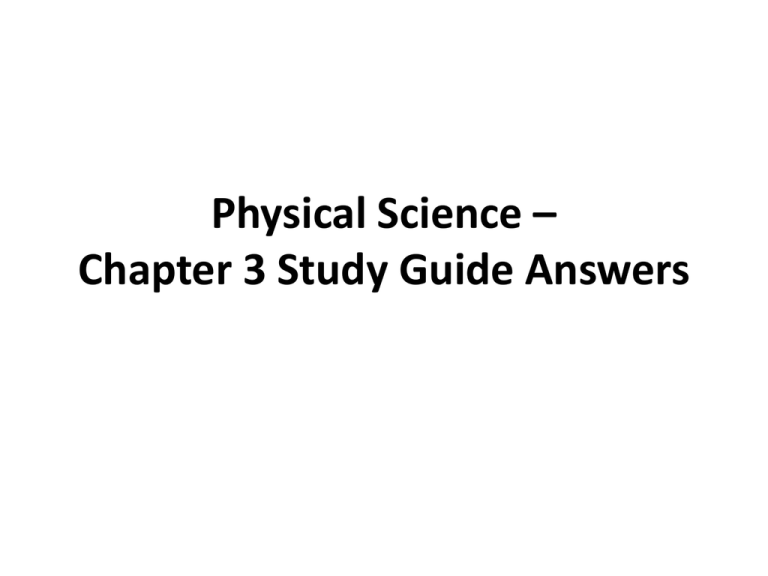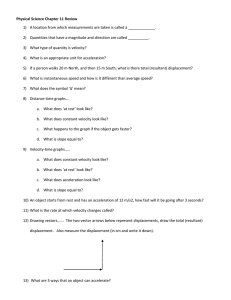Physical Science – Chapter 3 Study Guide Answers
advertisement

Physical Science – Chapter 3 Study Guide Answers Distinguish between distance and displacement. (Know the definitions) • Distance = how far (scalar quantity) • Displacement = distance and direction of an object (vector quantity) Calculate the average speed of an object. (Know the equation) • Average speed = total distance traveled divided by total time Explain the difference between speed and velocity. • Speed = distance an object travels per unit of time (scalar) • Velocity = speed and direction of a moving object (vector) Describe how acceleration, time and velocity are related. • Acceleration = change in velocity over time • Acceleration = final velocity minus initial velocity divided by time Explain how positive and negative acceleration affect motion. • Positive acceleration = speeding up, upward movement on the graph • Negative acceleration = slowing down, downward movement on the graph Write equations for the displacement and velocity of an object over time. • Velocity = displacement divided by time • Acceleration = change velocity divided by time Recognize and draw graphs of an objects displacement and velocity verses time. – Displacement vs. Time = VELOCITY GRAPH • Time Is on X—axis, Displacement is on Y-axis, Slope = velocity – Velocity vs. Time = ACCELERATION GRAPH • Time is on x-axis, velocity is on y-axis, slope = Acceleration, area below line is displacement Interpret motion diagrams – Drawings to demonstrate direction of motion, include forces if known Explain how forces and motion are related. • In order to have motion you need an unbalanced force Compare and contrast static friction and sliding friction. • Static friction = frictional force prevents 2 surfaces from sliding past each other Compare and contrast static friction and sliding friction. • Sliding friction = force that acts in opposite direction to the motion of a surface sliding past another surface Compare and contrast static friction and sliding friction. • Same = both involve surfaces, cause friction which generates heat • Different = Static prevents sliding, – Sliding opposite direction of motion Describe the effects of air resistance on falling objects. • Air Resistance is a form of friction • Caused by the interaction between an object and the air molecules it comes into contact with Describe the effects of air resistance on falling objects. • The bigger the object the more air resistance • The faster the object the more air resistance • Without air resistance all objects fall at the same acceleration Define motion • Occurs when an object changes position Define instantaneous speed. • Speed of an object at a given point in time Identify situations when distance and displacement are the same and situations when they are different. • Same – if you start and finish in different locations • Different – if you start and finish at the same spot Explain what happens if 2 objects have the same speed but different velocities. • Objects are travelling at the same speed but moving in different directions, or changing directions Define acceleration. • Change in velocity divided by time When does acceleration occur? • Anytime there is a change in velocity (slow down, speed up, change directions) What does the slope of a distance vs. time graph represent? • Speed/velocity What does the slope of a velocity vs. time graph represent? • Acceleration Define balanced force, unbalanced force, and net force. • Balanced force = forces equal in size but opposite in direction, cancel each other out • NO CHANGE IN MOTION Define balanced force, unbalanced force, and net force. • Unbalanced force = forces that are not equal in size and/or direction, combine to produce a net force that is not zero, can cause the motion of an object to change Define balanced force, unbalanced force, and net force. • Net force = when 2 or more forces act on an object at the same time, sum of all the forces acting on an object





